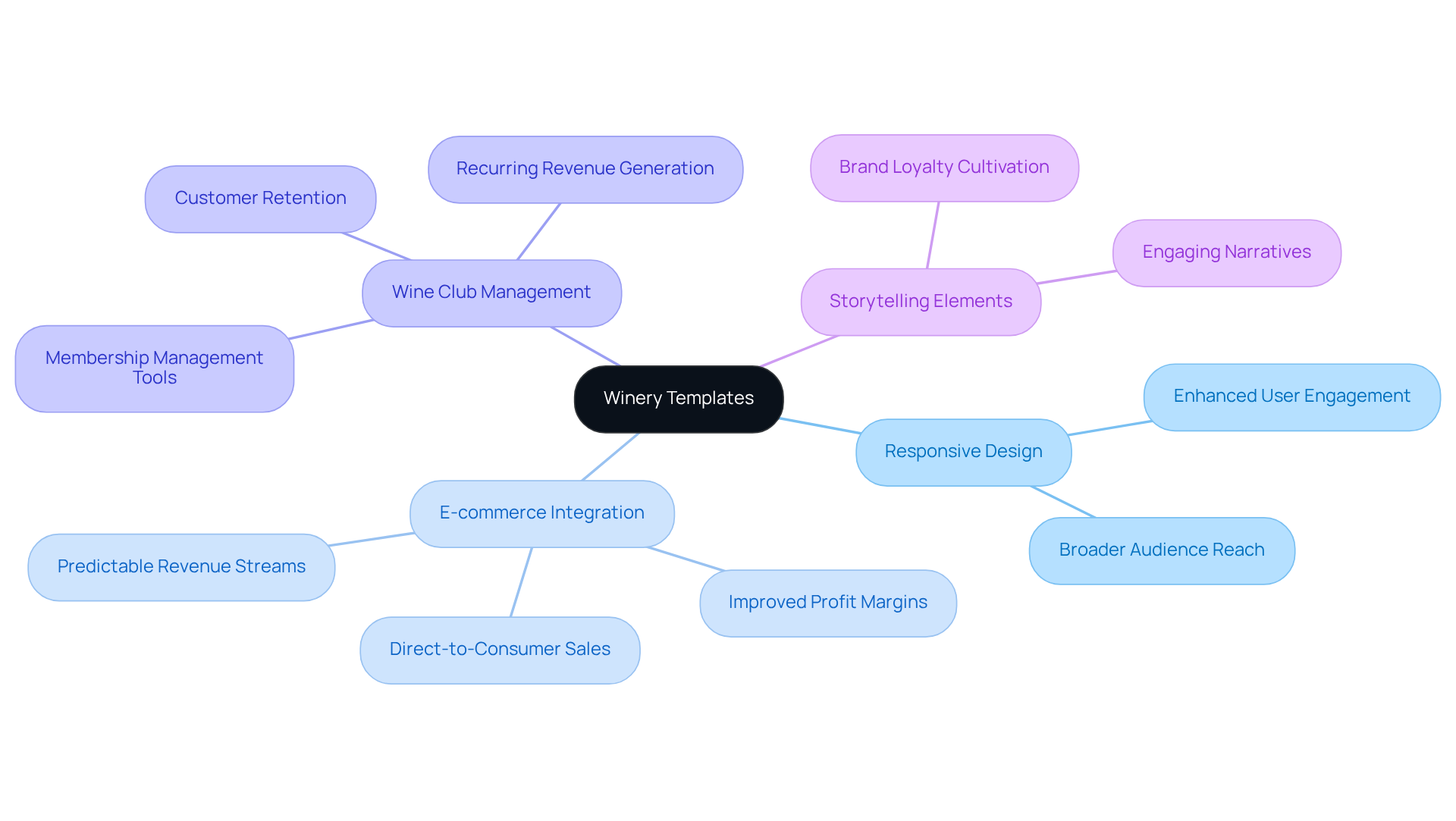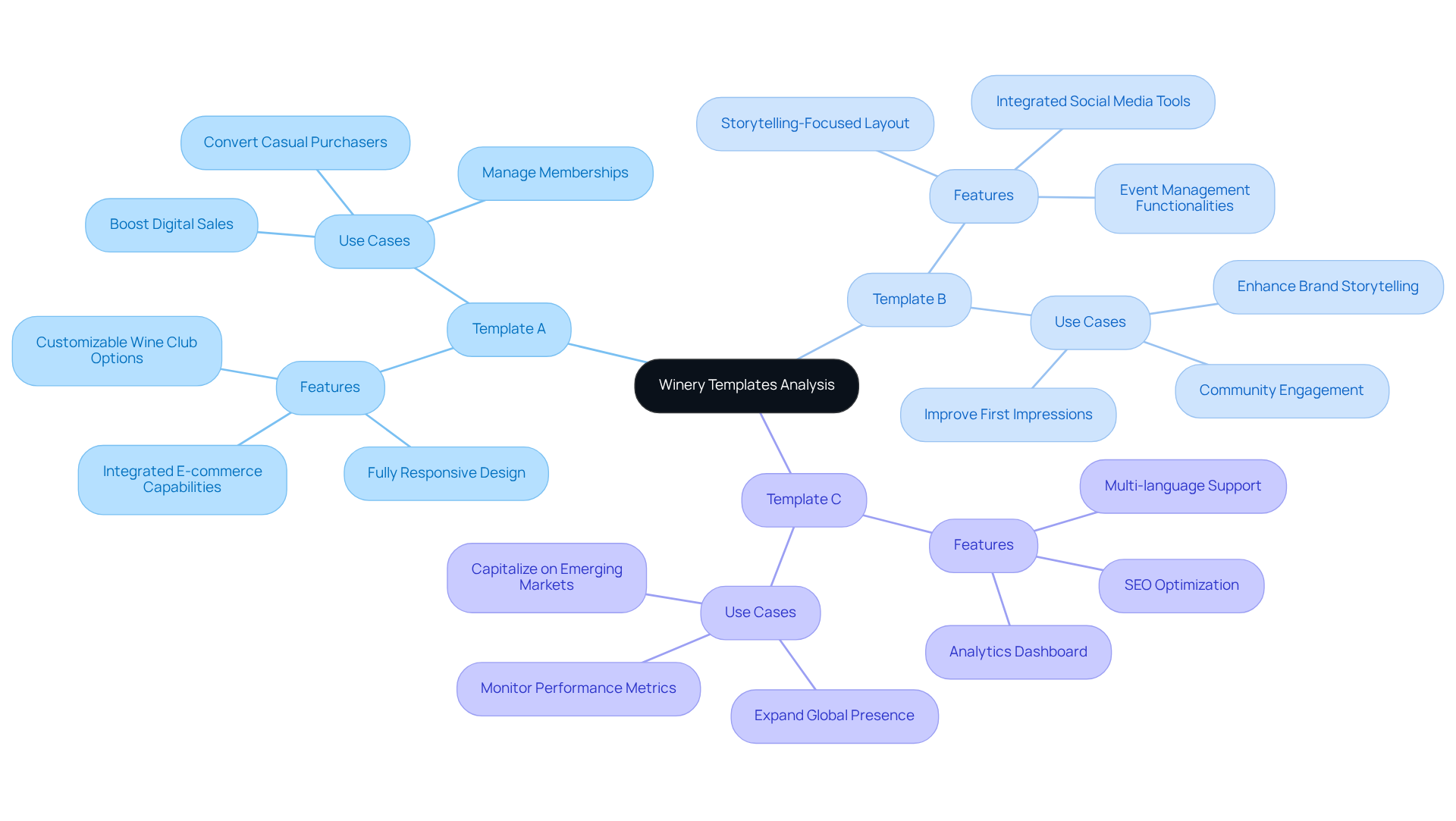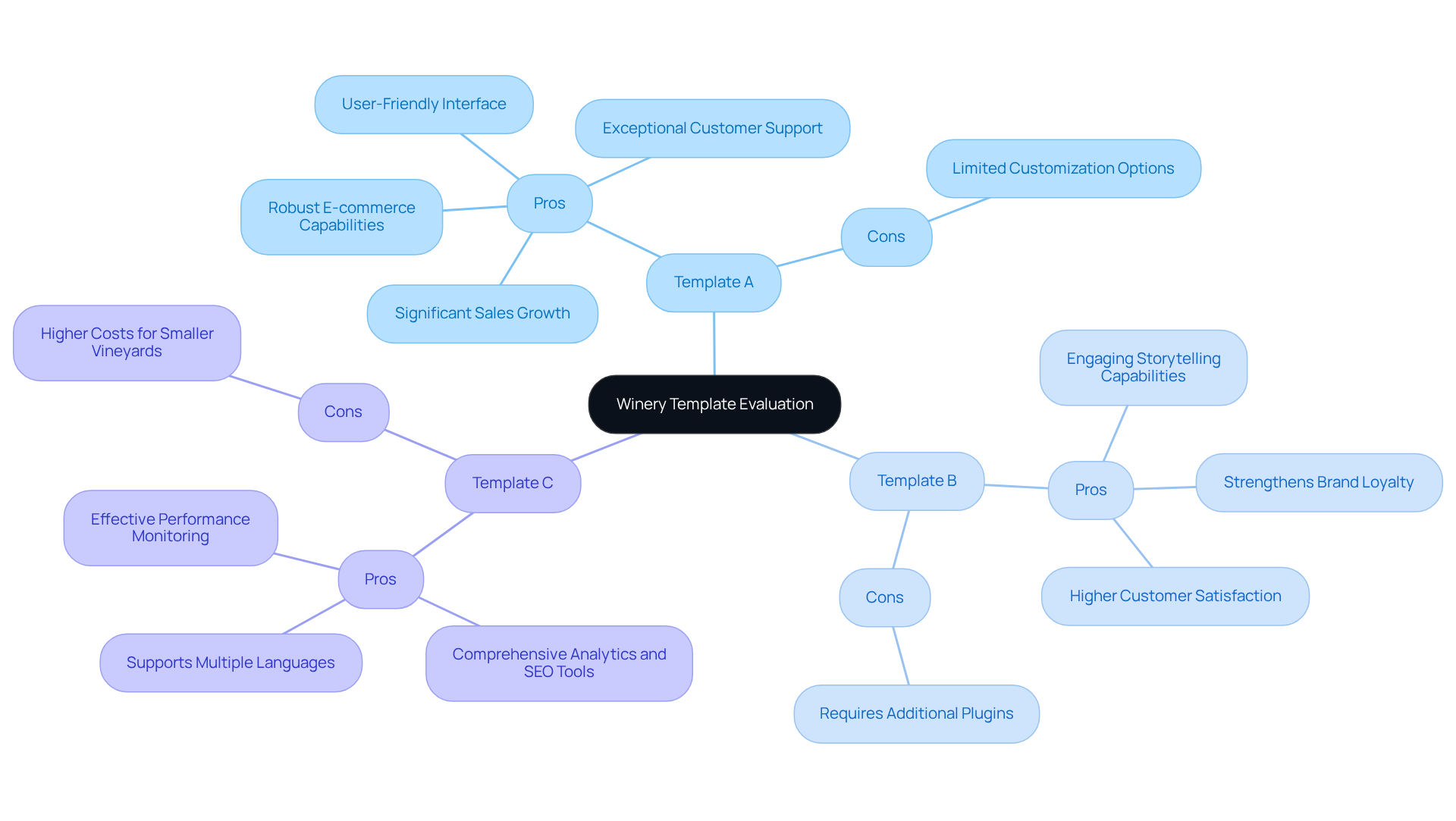Overview
This article provides a comprehensive comparison of various winery templates, meticulously outlining their key features, advantages, and disadvantages. The goal is to empower wineries to enhance their online presence and drive sales effectively.
Selecting the right template is not merely a choice; it is a critical decision that aligns with operational needs and long-term growth strategies. This is underscored by a detailed analysis of three specific templates, each tailored to address different facets of winery operations and consumer engagement.
By understanding these nuances, wineries can make informed decisions that propel their success.
Introduction
In today's digital landscape, winery templates have emerged as indispensable tools for vineyards seeking to enhance their online presence and seize the opportunities presented by the booming direct-to-consumer market. These specialized website designs not only address the unique requirements of wineries but also incorporate features that can significantly elevate online sales and customer engagement.
Yet, with a myriad of options available, how can wineries discern which template aligns best with their operational goals and brand identity?
This article embarks on a comparative analysis of popular winery templates, meticulously examining their features, benefits, and potential drawbacks, ultimately guiding wineries toward making informed decisions for their e-commerce strategies.
Understanding Winery Templates: Key Features and Benefits
Winery templates represent specialized website designs meticulously crafted for the wine sector, incorporating features that specifically address the unique needs of wineries. Among the key features are:
- Responsive Design: This guarantees that the website delivers an exceptional viewing experience across all devices, significantly enhancing user engagement. A responsive design is vital as it empowers vineyards to reach a broader audience, catering to the increasing number of consumers who prefer shopping on mobile devices.
- E-commerce Integration: This enables direct-to-consumer sales, allowing producers to sell their products online with ease. As we approach 2025, the importance of e-commerce integration cannot be overstated; it allows vineyards to bypass traditional distribution channels and connect directly with clients, fostering stronger relationships and improved profit margins. The 2023 Direct-to-Consumer Impact Report highlights that the DTC wine market is poised for substantial growth, emphasizing the necessity for wineries to implement robust e-commerce solutions that facilitate predictable revenue streams.
- Wine Club Management: Essential tools for managing memberships, subscriptions, and client engagement are crucial for fostering loyalty. A well-structured wine club can generate recurring revenue and bolster customer retention.
- Storytelling Elements: Sections dedicated to sharing the establishment's history, philosophy, and unique offerings are vital for cultivating brand loyalty. Engaging narratives resonate with consumers, increasing the likelihood of a meaningful connection with the brand.
Moreover, strategic capital planning is imperative for vineyards aiming to enhance their growth and investment opportunities, ensuring they can efficiently maintain and expand their direct-to-consumer channels.
The benefits of employing winery templates include improved client interaction, increased sales through optimized online commerce features, and the ability to convey compelling brand narratives that resonate with consumers. These models aid vineyards in establishing a professional digital presence, which is essential in today's digital-first marketplace. Industry leaders emphasize that integrating e-commerce solutions not only streamlines operations but also enhances the overall customer experience, positioning it as a strategic necessity for businesses aspiring to achieve long-term success.

Comparative Analysis of Top Winery Templates: Features and Use Cases
In this comparative analysis, we examine three popular winery templates, each meticulously crafted to address distinct operational needs and bolster online presence while driving predictable DTC revenue:
-
Template A:
- Features: This template features a fully responsive design, integrated e-commerce capabilities, and customizable wine club options.
- Use Case: Particularly effective for vineyards aiming to boost digital sales while adeptly managing memberships, the winery templates provide a user-friendly interface that fosters seamless transactions. This is crucial as online wine sales surged to $6 billion in 2021, reflecting a staggering 131% increase from the previous year. Moreover, the average yearly growth rate of wine e-commerce in the U.S. stands at approximately 20%, indicating substantial growth potential for wineries adopting this model. By converting casual purchasers into committed club members, this approach aligns with established strategies for sustainable growth, including crafting narratives that resonate with consumers.
-
Template B:
- Features: This template boasts a storytelling-focused layout, integrating social media tools and event management functionalities.
- Use Case: Best suited for wineries that prioritize brand storytelling and community engagement through events, winery templates effectively resonate with consumers. Notably, 50% of them form their first impression of a business based on its website design, making this template a strategic choice for enhancing brand visibility. Furthermore, 44% of American consumers placed their first-ever online wine and liquor orders during the pandemic, underscoring the growing trend of online purchasing. By weaving compelling narratives, vineyards can significantly enhance their DTC strategies and cultivate loyalty.
-
Template C:
- Features: This template excels in SEO optimization, includes an analytics dashboard, and supports multiple languages.
- Use Case: Ideal for vineyards looking to expand their global presence and efficiently monitor performance metrics, this model can assist wineries in utilizing winery templates to capitalize on emerging markets. Given that the average yearly growth rate of wine e-commerce in the U.S. is approximately 20%, leveraging this framework can be advantageous. Additionally, mobile optimization is paramount as an increasing number of users access websites via smartphones, rendering this design's features especially relevant. Strategic capital planning can further enhance the effectiveness of this framework in reaching broader audiences.
Each model showcases unique characteristics tailored for various aspects of winery operations, utilizing winery templates to boost sales and enhance storytelling. For instance, the evolution of Trentham Estate Winery from a WordPress branding site to a comprehensive eCommerce platform illustrates how selecting the right design can elevate market presence and operational efficiency, particularly through strategic capital planning and DTC revenue generation. Wineries must carefully evaluate their specific requirements and goals to select the most suitable framework for their e-commerce strategy, ensuring alignment with transformative DTC strategies and capital advisory for sustained growth.

Evaluating Pros and Cons: Selecting the Right Template for Your Winery
Selecting the appropriate winery templates is crucial for wineries that aim to enhance their online visibility and drive e-commerce growth. Below is a detailed overview of three popular templates, emphasizing their respective advantages and disadvantages:
-
Template A:
- Pros: This template boasts robust e-commerce capabilities, facilitating a seamless shopping experience for customers. Its user-friendly interface simplifies navigation, and exceptional customer support elevates user satisfaction. Wineries utilizing this template have reported significant increases in online sales, with some experiencing growth rates exceeding 190%. This aligns with Enocap's strategy of unlocking direct-to-consumer revenue for family-owned vineyards.
- Cons: Customization options for design are somewhat limited, potentially restricting branding opportunities for businesses seeking to establish a unique online identity.
-
Template B:
- Pros: This template features engaging storytelling capabilities that resonate well with consumers, making it ideal for community building. It fosters relationships between vineyards and their clients, thereby strengthening brand loyalty. Wineries employing this framework have noted higher customer satisfaction rates, particularly in engagement and community interaction. This highlights the significance of brand storytelling in Enocap's transformative DTC strategies.
- Cons: Achieving full functionality may require additional plugins, which could complicate the setup process and increase overall costs.
-
Template C:
- Pros: Equipped with comprehensive analytics and SEO tools, this template supports multiple languages, making it suitable for wineries targeting diverse markets. Its advanced features allow vineyards to effectively monitor performance metrics, aiding in strategic decision-making—an essential aspect of capital planning emphasized by Enocap.
- Cons: The higher costs associated with this design may pose a challenge for smaller vineyards, necessitating a thorough evaluation of budget against potential return on investment.
By carefully assessing these factors, wine producers can select winery templates that meet their current operational needs while also aligning with their long-term growth and client engagement strategies. As one vineyard proprietor stated, "The appropriate framework enhanced our online visibility and enabled us to engage more profoundly with our clients." This underscores the critical nature of thoughtful template selection in the competitive wine market, resonating with Enocap's mission to empower family wineries to thrive for generations.

Conclusion
Selecting the right winery template is not just beneficial; it is essential for wineries aiming to thrive in an increasingly digital marketplace. Specialized website designs that cater to the unique needs of the wine industry are paramount. Effective templates can significantly enhance online presence, streamline e-commerce operations, and foster deeper connections with consumers.
Key features such as responsive design, e-commerce integration, wine club management, and storytelling elements are crucial in attracting and retaining customers. A comparative analysis of three popular templates reveals distinct advantages and potential drawbacks, emphasizing the necessity for wineries to assess their specific operational needs and goals. By carefully considering these factors, wineries can optimize their digital strategies and leverage the growing direct-to-consumer market.
As the wine industry evolves, embracing the right winery template can serve as a catalyst for growth and engagement. Wineries must explore these options thoughtfully, ensuring alignment with transformative DTC strategies that not only boost sales but also create lasting relationships with customers. Investing in tailored solutions positions vineyards for sustainable success in a competitive landscape.
Frequently Asked Questions
What are winery templates?
Winery templates are specialized website designs tailored for the wine sector, featuring elements that address the unique needs of wineries.
What is the importance of responsive design in winery templates?
Responsive design ensures that the website provides an exceptional viewing experience across all devices, enhancing user engagement and allowing wineries to reach a broader audience, especially mobile shoppers.
How does e-commerce integration benefit wineries?
E-commerce integration enables wineries to sell products directly to consumers online, bypassing traditional distribution channels. This fosters stronger client relationships and improves profit margins, which is increasingly necessary as the DTC wine market is expected to grow significantly.
What role does wine club management play in winery templates?
Wine club management tools are essential for handling memberships, subscriptions, and client engagement, helping to foster customer loyalty and generating recurring revenue.
Why are storytelling elements important in winery templates?
Storytelling elements allow wineries to share their history, philosophy, and unique offerings, which helps cultivate brand loyalty and creates a meaningful connection with consumers.
What are the overall benefits of using winery templates?
The benefits include improved client interaction, increased sales through optimized online commerce features, and the ability to convey compelling brand narratives, all of which help establish a professional digital presence essential for success in today's marketplace.
How does strategic capital planning relate to winery templates?
Strategic capital planning is crucial for vineyards aiming to enhance growth and investment opportunities, enabling them to maintain and expand their direct-to-consumer channels effectively.




